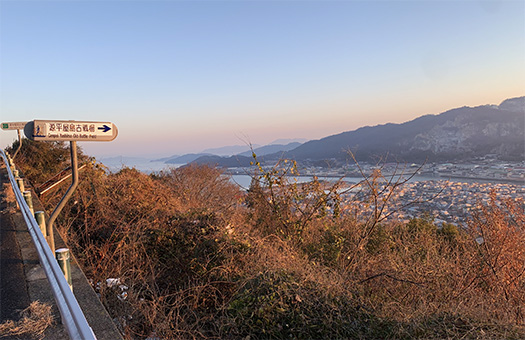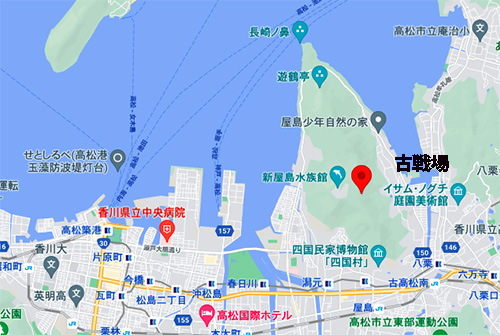

いま屋島を訪れると、瀬戸内海の風光明媚な温暖観光地ですが、
歴史としては古代国家での白村江敗戦以降の本土防衛戦の枢要地、
そして源平合戦での主要な戦闘地域ということで、
日本全体でのその軍事地理的重要性が明瞭だと言える。
白村江敗戦が663年であり、源平合戦は1185年3月なので522年の時間差。
しかし、源平期にはたぶん古城として「屋嶋城」は存在し、
古代以来のその戦略的立地性には疑いの余地もなかったに違いない。
木曽義仲によって京都を撤退した平家は西国に逃れたとき、
瀬戸内海の制海権という平家伝来の最重要戦略資産に依拠し、
政治的正統性を担保するのに安徳帝という幼君を推戴していた。
そういった状況を勘案すれば屋島が当座の根拠地として防御を固めたのは
無理からぬ戦略スタンスだとも思える。
治天の君としての後白河としてはすでに三種の神器なしで安徳に変わる天皇を
擁立していたとはいえ、その正統性には疑義もあり、
政治動乱が終結すれば安徳と三種の神器は「話合い」の重要政治資産にはなる。
平家としてはこの玉体が政治的生命線であったことがわかる。
そういういわば防衛スタンス一択であったことが軍事的には守勢を余儀なくさせた。
その思考法から「屋島」という根拠地選択にもなったのだろう。
ただ、こういった守勢一択の戦略方針では軍事的には士気を減衰させる。
ほんの少しのマイナス事象で心理的恐怖を呼びやすくなる。

政治としては京都の政局が最大のポイントだが、
一方で戦争は各地の実質的支配層・有力武士団が帰趨を制する。
各地に残る「平家落人」伝承の多さを考えると
「こんなハズでは」と考えた同時代人は相当多かったに違いない。
日本史の中でもこの時期の平家の滅亡ぶりは空前絶後のあっけなさ。
政治と軍事のバランス感覚がまったく機能していない。
っていうか、攻めると守るでは「攻める」方がはるかに優位に立てる。
攻める源氏軍は部隊を2つに分けて機動軍は大将義経が指揮して
浪速の港から徳島に上陸し現地武士団亀裂を加速させ陸路から屋島を急襲した。
それまでの平家の治世を常識と考えて現地武士団の違背を疑いもしなかった平家は
常識的戦略方針は「敵は軍船で海からやってくる」と一択戦略で守備していた。
忠誠を誓っていた四国の武士団の内実がバラバラとは平家は予想していなかった。
「俺たちには安徳天皇までいる」という正統性認識バイアス。
それが、敵がまさか「陸から来た」ことで露わな戦略失策が軍事の動転を呼んで
たぶん安徳の身の安全最優先で拠点を動かし舟に移動した。
陸を押さえた少数軍の義経は、寡兵でありながら突撃を繰り返させた。
やがて義経の少数軍ぶりがわかってきて平家も反撃し始めるが
後詰めとしての源氏側の正規軍船団が戦場に到着する状況が迫ってきて
安徳の身の安全最優先の平家軍は屋島を捨てて敗走していった。
ちなみにわが家系で関係の深い伊予・河野家一統はこの時期源氏に寝返っている。
祝賀の宴席の折敷の順番で頼朝、北条家に次いで「三の字」が書かれていて
そこに座ることが出来たことに感激しそれを家紋にした、という伝承が伝わる。
家系の古民家の屋根瓦にこのシルシが残ったりしているのですね。
English version⬇
[Genpei Warfield “Battle of Yashima” Shikoku / Yashima-4]
When you visit Imayajima, it is a scenic warm tourist destination in the Seto Inland Sea.
Historically, the centerpiece of the mainland defense battle after the defeat of Baekgang in the ancient nation,
And because it is the main battle area in the Genpei War,
It can be said that its military geographic importance in Japan as a whole is clear.
The Battle of Baekgang was defeated in 663, and the Battle of Baekgang was in March 1185, so there was a time lag of 522 years.
However, in the Genpei period, “Yashima Castle” probably existed as an old castle,
There must have been no doubt about its strategic location since ancient times.
When Heike, who withdrew from Kyoto by Yoshinaka Kiso, fled to Saigoku,
Relying on the most important strategic asset of the Heike clan, the command of the sea in the Seto Inland Sea,
To ensure political legitimacy, he was pushing for a young child named Antoku.
Considering such a situation, Yajima solidified the defense as a base for the time being.
It seems to be a reasonable strategic stance.
As Go-Shirakawa as the prince of the heavens, the emperor who already turns into an virtue without three kinds of sacred treasures
Even though it was upheld, its legitimacy was questionable,
When the political turmoil ends, Antoku and the three sacred treasures will become important political assets for “discussion.”
For the Heike, it turns out that this ball was the political lifeline.
So to speak, the choice of defense stance forced the military to defend itself.
From that way of thinking, it may have become the basis for choosing “Yashima.”
However, such a defensive choice strategic policy will dampen morale militarily.
Even the slightest negative event can easily lead to psychological fear.
Kyoto’s political affairs are the biggest point in politics,
On the other hand, in the war, the substantive rulers and influential samurai corps in each region control the return.
Considering the large number of “Heike Ochijin” folklore that remains in various places
There must have been quite a lot of contemporaries who thought, “In such a bad situation.”
The destruction of the Heike during this period in Japanese history is unprecedented.
The sense of balance between politics and military is not working at all.
I mean, if you attack and defend, “attacking” gives you a far advantage.
The attacking Genji army divides the unit into two, and the mobile army is commanded by General Yoshitsune.
It landed on Tokushima from the port of Naniwa, accelerated the cracks of the local samurai corps, and swooped on Yajima from the land route.
Heike who considered the reign of the Heike until then as common sense and did not doubt the violation of the local samurai corps
The common-sense strategic policy was to defend with an alternative strategy that “enemy comes from the sea by warship”.
Heike did not expect that the truth of the Shikoku Bushidan, who had vowed allegiance, would fall apart.
Legitimacy recognition bias that “we even have Emperor Antoku”.
However, the strategic missteps revealed by the fact that the enemy “come from the land” caused military upset.
Perhaps I moved the base and moved to the boat with the highest priority on the safety of Antoku.
Yoshitsune, a minority army who held the land, made him repeat the assault even though he was a mercenary.
Eventually, Yoshitsune’s minority army became known and Heike began to fight back.
The situation where the regular army fleet on the Genji side arrives at the battlefield as a back-up is approaching
The Heike army, which puts the highest priority on the safety of the Taira clan, abandoned Yajima and routed.
By the way, the Iyo and Kono clan, who are closely related to our family, turned over to Genji at this time.
Yoritomo, the Hojo clan, and then the “three characters” are written in the order of the banquet folds.
It is said that he was impressed by the fact that he was able to sit there and made it a family crest.
This shirushi remains on the roof tiles of old folk houses of the family.







コメントを投稿
「※誹謗中傷や、悪意のある書き込み、営利目的などのコメントを防ぐために、投稿された全てのコメントは一時的に保留されますのでご了承ください。」
You must be logged in to post a comment.